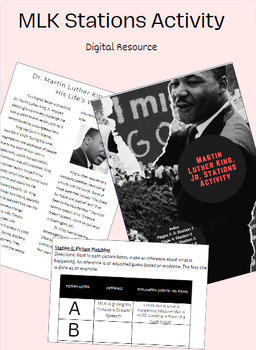Martin Luther King Activity Bundle Digital Resource
- Zip
Products in this Bundle (5)
Description
This bundle includes stations printouts, speech analysis, and task cards about Martin Luther King Jr.
Stations Activity:
Description: This digital resource for Martin Luther King Jr. Day is a great activity for independent station work for students in middle school English or reading class. The stations focus on reading comprehension, making inferences, analysis and creativity. This could be printed out and used as a physical station activity or put into a PowerPoint / PDF for an online gallery walk. I prefer to have students walk around the classroom.
Set Up: Print the directions for the stations along with the speech, the article, and the pictures. Hang these up around the room. Then, print the student packets. Students should have about 10 minutes at each station to have enough time to complete the work.
Includes:
-station directions
-original article
-speech
-pictures
-student packet
-answer keys
Speech Analysis:
This digital resource is intended for high school students to study Martin Luther King's infamous "I Have a Dream" Speech. The transcript of the speech is provided as well as a section for student annotations / notes while reading. There are some reflection questions as well.
This product does include an answer key for the figurative language in the speech.
Task Cards:
Description: These Martin Luther King Jr. task cards are great for MLK day. The task cards address skills in research, reading, and writing. This is a digital resource. There are 16 unique task cards that each address an important aspect of MLK's life: speeches, quotes, biography, and activism.
A few ways to use task cards:
1. Use the cards in stations or centers. If you want your students to work together, place 4 cards at each station around the room. Give students time to answer and complete each task. After time is up, tell students to go to the next station. Continue until students have gone to every station.
2. Give one task card to each student and ask them to work independently. After 10 minutes or so, have students switch cards to complete another task.
Dream Wall
This MLK Day resource allows students to be creative while critically thinking about Martin Luther King Jr. Day. Students can decorate their clouds with their dreams for themselves, their schools, communities, and the world. This is a great activity to turn into a bulletin board. Letters spelling "I Have a Dream" for a bulletin board are included.
Coloring Pages
This digital resource contains 9 unique coloring pages with different quotes from Martin Luther King Jr. These coloring pages are perfect for MLK Day, and you can make a bulletin board of students' work when they are done!


